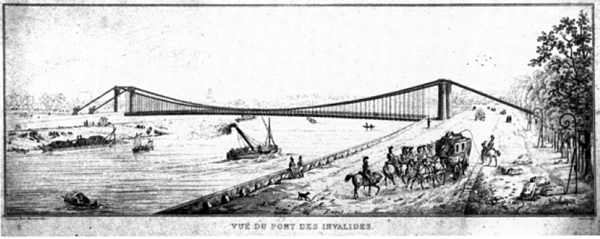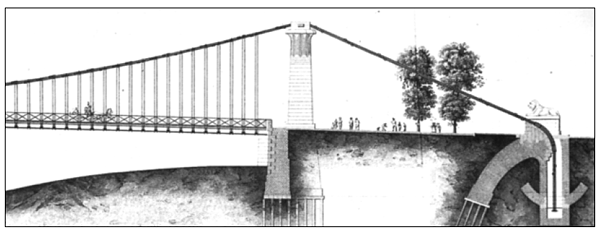Claude-Louis Navier
by Andrew Boyd
Today, building bridges. The University of Houston's College of Engineering presents this series about the machines that make our civilization run, and the people whose ingenuity created them.
Claude-Louis Navier was a man trapped in the middle. In 1802 he entered the École Polytechnique where he became entranced with mathematics. A few years later, following in the footsteps of his uncle, he went on to study and teach at one of France's Grandes Écoles, the École Nationale of Bridges and Roads. And here's where Navier's problems began.
The École Nationale of Bridges and Roads was a school of rough and tumble engineering. The science behind bridge building at the time was largely empirical. What materials worked best? What bridges held up well?
Navier realized what mathematics had to offer, and the textbooks he wrote gave students a look at the theory behind bridge building. But he was first and foremost expected to teach bridge building. Were his mathematical excursions useful, or unnecessary diversions?

Suspension bridges were flourishing in the 1820s, and at the behest of the French government Navier was sent to Britain to study what the practically minded bridge builders of the day were up to. Ever in character, Navier returned to France and wrote an important book that tackled suspension bridge design in unflinchingly mathematical terms. And he went one step further. He completed detailed designs for a lengthy suspension bridge in the center of Paris. It was to serve as a monument to the greater glory of France: grand, pleasing to the eye, and a demonstration of intellectual prowess.
Navier lined up financing, and the resplendent bridge was built. But just weeks before it was opened to the public, the unthinkable happened. A broken water pipe caused one of the bridge's buttresses to crack. In fact, it was only one of many cracks encountered during construction, and it proved to be the straw that broke the camel's back. Accusations flew. A government committee was formed to investigate. And a decision was made: dismantle the unsafe bridge.

In a highly politicized statement, the committee criticized the design for relying too much on mathematics while at the same time praising the superior, non-mathematical achievements of the British. (That's quite a rebuke coming from the French.) In point of fact, Navier had relied too much on mathematics. His design was untried, yet he didn't build scale models to test it. He also built the bridge exactly as the math told him, rather than making it a little stronger "just in case."
Navier's theoretical work was sufficiently groundbreaking that it's still taught in many different corners of math and engineering. The celebrated Navier-Stokes equations remain a centerpiece of the math describing fluid flows. But Navier's bridge building story reemphasizes an important lesson. Math is a wonderful tool — a tool that's literally taken us to the moon and back. But engineers can't afford to fall in love with the math. It's the sculpture, not the chisel, that's all important.
I'm Andy Boyd at the University of Houston, where we're interested in the way inventive minds work.
Notes and references:
Thanks to Professor Ridgway Scott of the University of Chicago for bringing this story to my attention.
Navier's bridge, the Pont des Invalides, was built on the site of the current Pont Alexandre III. A new Pont des Invalides is just downstream from the original site.
M. Cannone and S. Friedlander. 2003. Navier: Blow-up and Collapse. Notices of the American Mathematical Society 50(1): pp. 7-13. See also: http://www.ams.org/notices/200301/fea-friedlander.pdf. Accessed September 25, 2012.
E. Kranakis. Constructing a Bridge: An Exploration of Engineering Culture, Design and Research in Nineteenth-Century France and America. Cambridge, Massachusetts: MIT Press, 1997.
The sketches of Navier's bridge are in the public domain as a result of copyright expiration.
This episode was first aired on September 27, 2012